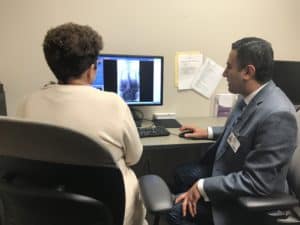Last fall, just getting out of a chair and walking from one room to the next was a labored and painful experience for Denise Frerichs. The pain was excruciating and it ran down from her back to her legs.
“The pain started about two years ago. At first I thought it would get better. I took out a walking stick that I’d used from hiking to help me get around.”
Over the next several months Frerichs progressed from the walking stick to a cane and eventually a walker. Along with scoliosis, one of Frerichs’ vertebrae in her lower back, slipped forward over the one below it.
“The doctors told me my L4 slipped down in front of my L5. It had me out of whack.”, Frerichs said.
She initially tried conservative treatment including physical therapy, injections and medication but they only helped a little. After a referral, she scheduled an appointment with Noojan Kazemi, M.D., a complex spine and neurosurgeon at UAMS.
Kazemi specializes in complex back surgeries. He tailored a surgical plan that would treat both her scoliosis and the disc slippage.
“We divided the surgery into two stages,” Kazemi said. “The first was a minimally invasive procedure that included a small incision to get to the spine. We then replaced the discs with grafts that helped straighten the spine.”
Stage two of the procedure was more complex and took several hours, Kazemi said. It involved putting in rods and screws that would loosen Frerichs’ spine to further correct the deformity and ease the pressure from the pinched nerves that was causing her leg and buttock pain.
“From the anesthesiologist, to the neuro monitoring team, scrub nurses and circulators, UAMS is very fortunate to have a group of people able to insure the success of complex procedures like this,” Kazemi said.
“It feels like everything is relaxed for the first time in years. I had been so tight before,” Frerichs said.
Frerichs’ comfort level after surgery is something that baffled her physical and occupational therapists, who thought she was being conservative when she ranked her pain on a scale from 1 to 10.
“I’d give them a 3 or a 4 and they’d say ‘are you sure?’ So I thought maybe it’s not actually that high and I would give a lower number. Turns out, they were thinking it should be much higher! They concluded the pain I was in before surgery was much worse than any pain after surgery,” Frerichs said.
She fights back tears when she thinks of the progression of her pain compared to how she feels now. Her husband, Mark Frerichs, captured video before her procedure, then two and four months after surgery. In each video, Frerichs gets a little faster and less dependent on assistance from a cane or walker. She’s also 3 inches taller.
The key to recovery is twofold, Mark Frerichs said. You have to be ambitious and have a good support system to help motivate you. Frerichs has been at the helm of his wife’s support system. They’ve been married 35 years and have an adult son. Now that she’s feeling better, he has to quicken his stride to keep up with her sometimes.
“I’m very grateful to Dr. Kazemi and so many others who have helped me get back on my feet.”



